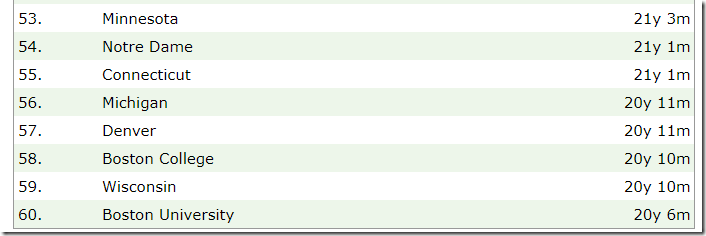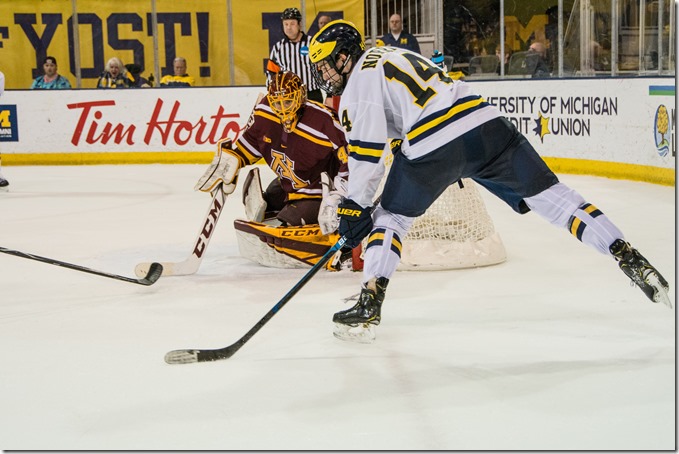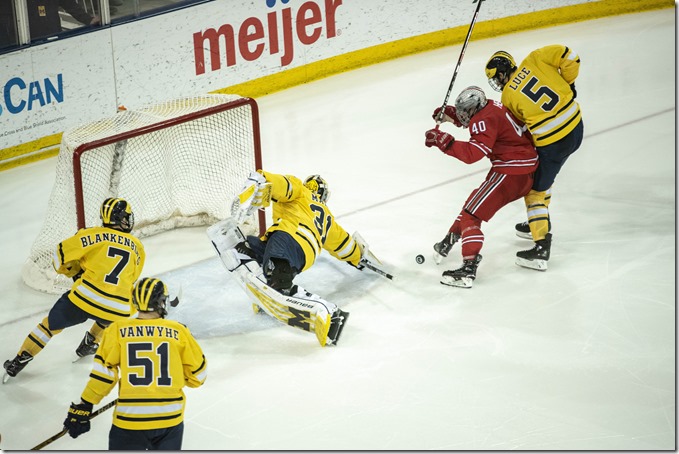
Let's Have A Hockey Autopsy

Hockey's season went out with a whimper as they were swept at the hands of Minnesota in the first round of the Big Ten tournament. That's disappointing but not particularly surprising for anyone who watched most of Michigan's season.
What went wrong? Michigan's various problems follow.
Age
Michigan was one of the youngest teams in the country, and the bottom of the age standings are pretty ugly:
ND and Denver are in the top 16 of the pairwise. Otherwise this is a list of the teams that generally recruit the best across college hockey and are struggling in the new over-30 NCAA. Not one of Minnesota, Michigan, BC, BU, or Wisconsin is in position for an at-large bid. It should be noted that 50-52 are Quinnipiac, Providence, and Harvard, who are all set for at-large bids, but even those teams in close proximity by rank are almost a half-year older than Michigan and the rest of the "we recruit the NTDP" class.
Under Pearson they've moved to taking more overagers, but those guys are all underclassmen. Michigan is in the process of having some 23 and 24 year olds; they are not there yet. At some point Michigan's going to be a mix of older players and high-level NHL prospects. Currently they are young and had 1.5 high-level prospects. Speaking of:
Talent level
Norris was M's only PPG scorer and missed half the year [Bill Rapai]
As discussed in the previous post about Michigan's gap year, this year's freshman class had zero drafted players for the first time in probably 20 years. Michigan found a good fourth line as Moyle and Van Whye emerged midseason; that line then became their de facto second line because nobody else was doing anything. Compounding matters was the previous class, which was Hughes and Norris (woot woot!) plus Mike Pastujov, whose star fell precipitously after his commitment, and then whatever Mel could scrape up. That turned out to be Becker and Raabe, two guys who have chipped in but aren't scoring line players at this point in their career.
So when Norris goes out midseason, they have zero underclassman forwards capable of playing on a scoring line. This is untenable for a program that is constantly getting raided by the NHL—you aren't getting Cooper Marody back for a senior year.
Michigan did have some guys: Lockwood put up 31 points in 36 games; Slaker and Pastujov put up 25 and 24. It's not a coincidence that two of the three top scorers were older draftees. There just weren't enough of them. Michigan has always been more talented than all of its opponents, which is how they make up the perpetual age gap. This year they weren't. Opposing goaltenders put up a .914; Michigan was 41st in shooting percentage. Even more telling: Michigan's power play conversion rate nearly halved from 19% (average-ish) to 10% (national worst) when Norris went out.
[After THE JUMP: woe! fie and woe!]
Disappointing Defensemen
Quinn Hughes is going to have a terrific NHL career but his sophomore year at Michigan was a disappointment. He led the team in scoring; he was –2. Michigan gave up a ton of odd man rushes because Hughes was either stripped of the puck or deep in the offensive zone when the puck turned over. The Penn State game in NYC was the most extreme example of this but far from the only one.
Nicholas Boka was similarly disappointing, frequently giving up odd man rushes himself and making some boggling errors in his own zone. He was –9.
There's significant Ewing Theory potential here if NTDP D Cam York comes in and can provide 80% of Hughes's offensive pop without fatally compromising Michigan's defense a few times a game. Michigan returns Nick Blankenburg, Jack Summers, (probably) Luke Martin, and Griffin Luce: those four D were +11, +2, +1, and +3, respectively. With York coming in only one of those guys is likely to move up to the top pair. The rest will be a year older, incrementally better, and facing approximately the same competition level.
Goaltending
Mann was slightly better [James Coller]
75 goalies played at least a third of their team's minutes this year. Amongst those qualifiers, Strauss Mann and Hayden Lavigne were 67th and 74th, respectively, in save percentage. The, uh, swashbuckling nature of Michigan's defensive corps had something to do with that. But for much of the year it felt like any grade A scoring chance was going in, and various other ones as well. Lavigne managing to give up four short-side goals in a loss was particularly memorable.
The good news, such as it is, is that at sample sizes like "half a college hockey season" something like save percentage is wildly variable. Mann had back to back .923s in the USHL and for the first time all season, in the playoff series the fact that Michigan gave up a bunch of goals on not many shots did not seem to be a thing the goalie was a large part of. I'd guess Michigan tries to ride with him next year and hopes that the .895 from this year seems like a bad dream. This isn't the worst plan.
The sum of all things
Thanks to Dave and Adam's diligent work we have a drill-down stat of some import: attempts from "home plate." That is this area:
Obviously that's the area of the ice where goals are most likely to come from. The nature of these shots still leaves a lot of fuzz in the data—a 5x5 shot generated off the cycle in the home plate area is a lot worse than a 2 on 1, probably—but it's a lot better than pure Corsi.
So. Michigan attempted shots from the plate: 634. Opponents: 567. That makes the respective team save percentages even crazier. Michigan had the Corsi profile of a tourney team, and the home plate profile of a tourney team, and had a save percentage of .887 while opponents had a .914.
In a way this is good news, as Corsi became a thing in hockey analytics circles because is was broadly more predictive than actual goals scored. Michigan may have just suffered One of Those Years when they were ill-prepared to out-talent it.
Is help on the way?
Some. There is going to be some clown car action first.
Michigan took a commitment from USHL 20-year-old Emil Ohrvall in mid-February. Twelve other players have already announced commitments to Michigan and are tentatively slated to come in next year. Michigan has four certain roster slots (three seniors and Quinn Hughes). Michigan Hockey Summer is likely to open up another couple (some combination of Norris, Martin, Lockwood, and Nick Pastujov to the NHL and possible playing time transfers).
That still leaves about two commits for every open slot. Michigan is clearly being up front with these guys that they might have to defer, because they put off four guys from the previous class without any of those guys trying to find another landing spot.
One man's attempt to filter the incoming class into tiers:
- Certainly coming: D Cam York (NTDP, first round pick), F Johnny Beecher (NTDP, third round pick), F Emil Ohrvall (20-year-old top ten USHL scorer), D Keaton Pehrson (followed Mel from Tech, has deferred twice), D Jacob Semik (already deferred, vaguely draftable last year, signed LOI)
- Light/no money? Nick Granowicz (MI native, will be 21, PPG in BCHL)
- Maybe: F Phillippe Lapointe (26 points in 39 USHL games, 19, father is ex-NHLer who now looks like the bad guy in a Liam Neeson movie), F Calen Kiefiuk (already deferred, 30 points in 33 USHL games).
- Deferred: D Steve Holtz (injured, has played only 19 games this year), F Nicholas Zabaneh(15 points in 36 USHL games, still 17), Dylan Wendt (8 USHL points, 18), Cassidy Bowes (24 points in 43 BCHL games), Jake Harrison (5'9" D with 10 points in USHL).
I'll go into more detail on the class in the annual hockey recruiting overview once junior seasons conclude. In short:
- York is the top scoring D on the NTDP and should be a high first round pick and will slot into Hughes's spot.
- Beecher's NHL profile has fallen a bit but he's huge, fast, and sixth in scoring on the most loaded NTDP of all time, he'll go right on a scoring line.
- Ohrvall is a PPG guy in the USHL as a 1998, which could go either way. Some of those guys spearhead the best teams in the over-30 edition of college hockey. Some are meh.
- One of Pehrson/Semik is likely to be the #6 D. That'll probably be fine. Both were vaguely draftable and have seen big point jumps in the USHL this year. Pehrson has an uncanny ability to avoid penalties.
- Granowicz looked for all the world like a career healthy scratch but he moved to the BCHL this offseason, scored a PPG(which isn't amazing as an overager in a very offensive league) and was named second-team All BCHL. He's from Michigan; my assumption with those guys is that they're mostly walk-ons Michigan hopes to grab a Van Wyhe from.
Beecher and Ohrvall should easily be better than half a season of Norris and Brendan Warren; if I had to bet I'd bet that York will score less but be better for the team than Hughes. With everyone else getting older the team should be considerably improved.
But goaltending looms.
Not one goalie recruit???
This year is kind of what I expected last year to be. The 16-17 team was hopelessly overmatched in almost every game, only winning shots/corsi a handful of times all year. Only Slaker and Lockwood even hit 20 points on the year (Marody was out for most of the season) and they netted 21 and 20, respectively.
So I thought last year scoring and talent would be a challenge and the team would float around 18-20 in PWR for a while and drift off. Instead, Marody and Calderone were scoring a point a game or more, Hughes was a boy genius, and they went to the Frozen Four.
And now, this year, we have a team struggling with talent shortages that hung out in the low 20s of PWR and then faded at the end.
The irony is that the team in 16-17 was actually really lucky to win 13 games with how much it got outshot and outplayed. This team frequently outplayed teams by statistical metrics and lost.
The noticeable difference? Michigan goalies couldn't even hit .900 in save percentage this year.
In 16-17, Michigan evenly split starts between Zach Nagelvoort, Hayden Lavigne, and Jack Lafontaine. Their numbers? .921, .912, and .911.
Gonna take some work on multiple fronts to get the team back into the tournament territory it belongs next year.
SOme are complaining about special teams performance and strategy, some I'm sure would look at the D as a unit being irresposible at times. Certainly the goaltending has not been where it needs to be.
Next year could be a great season but goaltending and Michigan Hockey Summer (TM) will work against us.
I like the overall direction of taking more overagers - you can't expect a team full of 18y/os will beat these (mostly eastern) teams with 24 y/o SRs no matter what round the youg guys were drafted into. Take some of the better overagers, and recruit the hell out of the talented 18y/os and blend the team to have a high floor (due to talent AND the older guys being consistent 4 year players) while bringing in the elite top players draftable in the 1st 3-4 rounds. In addition, the rolling 14 man classes stacked up every year where they take the 5-8 best guys based on attrition and defer the other to the following year is brilliant. It's morally legit oversigning (or grey shirting?) as long as they are upfront about the situation to the recruits - hedging their bets and thus mitigating the effects of Michigan Hockey Summer and the classic A grade guys who commit at 15 and progress to B grade prospects - some of whom could turn into an overager type 4 guy instead of sticking with them at 18, bringing them in and they underachieve
Postscript:
Highlight of the year? The new road jerseys. Best ever, IMO.
My only uniform beef: Just wrap the stripes all the way around. Like the socks in the Norris picture above, I have no idea why Nike thinks it's awesome to stop the sock stripes and jersey hem (and even the sleeve stripes now that I'm investigating) from connecting. I don't know what the point of this is. It looks cheap and incomplete and it makes me unhappy.
Frozen four in Detroit next year.
M will be there.
I'd like to think losing Norris made a difference but it didn't really. They were about 500 before and about 500 after.
Kiefiuk is a must get.
March 14th, 2019 at 10:54 AM ^
What is "NTDP"?
March 14th, 2019 at 11:14 AM ^
USA Hockey National Team Development Program.
https://www.usahockeyntdp.com/aboutus
Best under-18 US players all gathered right here in Michigan. Good place for college programs to recruit.
March 14th, 2019 at 11:19 AM ^
Thank you sir.




Comments